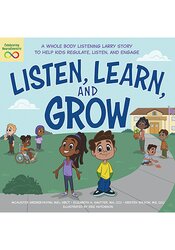Whole Body Listening Is Not One-Size-Fits-All

A few years ago, I planned to visit a good friend out of state for some hiking. Unfortunately, when I arrived, I realized that I had left my boots next to the front door at home! Thankfully, my friend had an extra pair. The only problem was she is a size 8.5. I’m a size 9. At first, it did not seem like a problem. The shoes were an okay fit. But as the hike went on, I soon realized that my feet—and even my body—quickly became really sore. Even the smallest difference in shoe sizes can make an otherwise pleasant experience much more difficult!
Similar to shoes, it is critical to find the best “fit” for our own listening profile. What works for one person may not work for others. This is especially impactful for learners who belong to traditionally marginalized communities, as their listening needs may differ significantly from the majority. This is why it is important to lean in with curiosity and compassion when supporting and guiding listeners so each person is able to meet their individual listening needs.
Listening is arguably one of the most critical, complex, multilayered skills in life. Listening is integrated into how we connect, communicate, learn, and evolve. It involves much more than ears hearing sounds and delivering them to your brain. Instead, it involves the whole body: ears, eyes, brain, mouth, body, feet, hands, and even heart. Suzanne Truesdale coined the term “Whole Body Listening” in 1990 to help students understand how their body is involved in listening. This concept was then joined with a character called “Whole Body Listening Larry,” along with learning materials to support educators in structuring the concept of listening with their students.
Larry found his way into many classrooms and homes. But he was selling only one shoe size, so to speak. Listening was done with eyes looking at the speaker, ears listening and following directions; mouth quiet; body, hands, and feet still; heart “caring” through standardized ways of showing empathy; and brain thinking about the person talking. This listening profile works for some, but for others, these strategies don’t help—and can even impede—their ability to listen. Larry’s strategies were not about what is best for the student but rather what was best for the speaker. It required children to perform external, standardized behaviors of appearing to listen rather than exploring strategies that aid the internal listening process. It was not a practice in listening, but a practice in compliance.
Since the inception of Whole Body Listening Larry, we have since learned more about differing brains and bodies. We are on a mission to transform these resources in order to bring change to classrooms everywhere. Our new book, Listen, Learn, and Grow: A Whole Body Listening Larry Story to Help Kids Regulate, Listen, and Engage, celebrates the many ways that your whole body can support listening. Some people listen better when they stand or move their body, some when they look away, and some when they hum or repeat back what they hear.
We want to amplify the voices of those who were told to fit into a listening profile that wasn’t their size. We want to support the exploration of what works for each individual learner. We want to help shift focus to regulation over compliance. We hope that you will join us on this important journey as well.
Similar to shoes, it is critical to find the best “fit” for our own listening profile. What works for one person may not work for others. This is especially impactful for learners who belong to traditionally marginalized communities, as their listening needs may differ significantly from the majority. This is why it is important to lean in with curiosity and compassion when supporting and guiding listeners so each person is able to meet their individual listening needs.
Listening is arguably one of the most critical, complex, multilayered skills in life. Listening is integrated into how we connect, communicate, learn, and evolve. It involves much more than ears hearing sounds and delivering them to your brain. Instead, it involves the whole body: ears, eyes, brain, mouth, body, feet, hands, and even heart. Suzanne Truesdale coined the term “Whole Body Listening” in 1990 to help students understand how their body is involved in listening. This concept was then joined with a character called “Whole Body Listening Larry,” along with learning materials to support educators in structuring the concept of listening with their students.
Larry found his way into many classrooms and homes. But he was selling only one shoe size, so to speak. Listening was done with eyes looking at the speaker, ears listening and following directions; mouth quiet; body, hands, and feet still; heart “caring” through standardized ways of showing empathy; and brain thinking about the person talking. This listening profile works for some, but for others, these strategies don’t help—and can even impede—their ability to listen. Larry’s strategies were not about what is best for the student but rather what was best for the speaker. It required children to perform external, standardized behaviors of appearing to listen rather than exploring strategies that aid the internal listening process. It was not a practice in listening, but a practice in compliance.
Since the inception of Whole Body Listening Larry, we have since learned more about differing brains and bodies. We are on a mission to transform these resources in order to bring change to classrooms everywhere. Our new book, Listen, Learn, and Grow: A Whole Body Listening Larry Story to Help Kids Regulate, Listen, and Engage, celebrates the many ways that your whole body can support listening. Some people listen better when they stand or move their body, some when they look away, and some when they hum or repeat back what they hear.
We want to amplify the voices of those who were told to fit into a listening profile that wasn’t their size. We want to support the exploration of what works for each individual learner. We want to help shift focus to regulation over compliance. We hope that you will join us on this important journey as well.
Listening Larry is back, and he’s learned a few things about neurodiversity.

Listen, Learn, and Grow is a delightful rhyming story that explores the many ways kids can use their whole body as a listening tool. And here’s a hint: Listening looks different for everyone!
Readers will join Larry and his friend Lori in their classroom as they discover that listening is more than just “hearing” with their ears. It’s about using their eyes, ears, mouth, hands, feet, body, brain, and heart to help them remain regulated, focused, and engaged so they can be successful learners at school.
As a bonus, Listen, Learn, and Grow also includes a variety of activities that educators and parents can use at home, in the classroom, and in the community to encourage whole body listening throughout the day.
Readers will join Larry and his friend Lori in their classroom as they discover that listening is more than just “hearing” with their ears. It’s about using their eyes, ears, mouth, hands, feet, body, brain, and heart to help them remain regulated, focused, and engaged so they can be successful learners at school.
As a bonus, Listen, Learn, and Grow also includes a variety of activities that educators and parents can use at home, in the classroom, and in the community to encourage whole body listening throughout the day.
Meet the Expert:
Elizabeth A. Sautter, MA, CCC, is a speech-language pathologist, speaker, author, and trainer with expertise in social-emotional well-being. She is the author of the parent activity book Make Social and Emotional Learning Stick, and co-author of Listen, Learn, and Grow, along with many other resources for parents, including an online course and community. Elizabeth collaborates with the Zones of Regulation team as a trainer and is a co-author of other Zones products, including children’s books, card decks, and games.
Learn more about her educational products, including upcoming live seminars, by clicking here.
Learn more about her educational products, including upcoming live seminars, by clicking here.



